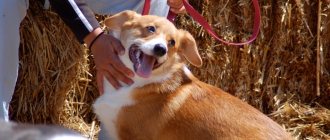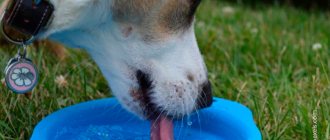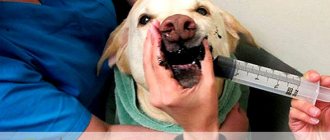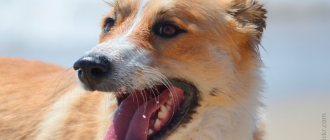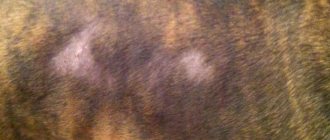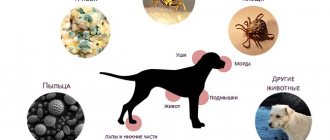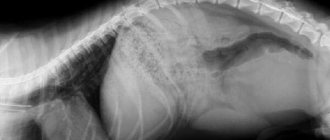Toy terriers, representatives of the class of decorative dogs, infinitely sweet and devoted creatures, will become a family favorite and your constant companion.
After all, having a compact size, they can fit even into a medium-sized handbag and travel with their beloved owner.
Also, toys do not require complex care and regular walks - they can go to the toilet in the tray.
They will never cease to delight you with their playful character and cheerful disposition.
But, like any other living beings, they also have health problems.
Let's look at the case when your pet wheezes and suffocates.
Physiological features of toy terriers
The Toy Terrier is a small (also called “pocket”) dog, with an average height of 20-30 cm and an average weight of 1.5 to 3 kg.
live
from 12 to 15 years .
These pets are thin-boned, with high legs, square in shape with angular muscles. A wedge-shaped head, a rounded skull and a convex wide forehead are also characteristic features of the breed.
Read more about what Toy Terriers look like here.
To establish proper dog breathing, the transverse cartilaginous half-rings of the trachea provide the necessary rigidity so that the trachea does not collapse during inhalation, and the softer parts ensure its plasticity.
Prevention measures
If, for example, a Spitz grunts and wheezes, as if it is suffocating, in order to avoid unpleasant symptoms you should:
- provide your pet with a balanced and varied diet;
- organize a room for keeping the dog so that it is warm, protected from winds and cold;
- do annual preventive deworming;
- double-check the sanitary and hygienic standards for keeping the animal.
A balanced diet is essential to maintaining your pet's health.
Causes of wheezing and difficulty breathing
Sometimes toy owners may notice strange noises, reminiscent of wheezing, when the pet breathes, especially during active play, after eating and drinking water, and also when the pet is nervous (at such moments the toy also usually trembles), that is, during moments of intense and deep breathing .
Sometimes the owner does not attach much importance to this, but wheezing can be an alarming symptom and be in the nature of a pathology of the respiratory system.
Let's look at the main reasons why a toy terrier may wheeze and choke.
Development of tracheal collapse
This defect is caused by compression (narrowing) of the tracheal lumen due to softening and laxity of the tracheal cartilage.
This condition causes a temporary spasm of the larynx, and the dog coughs as if he wants to get rid of a foreign object, wheezes and even grunts his nose.
It is necessary to take into account the fact that toy terriers are prone to lung collapse, so it is important to notice other symptoms of this disease.
At the first appearance of a cough, you should go to the hospital, and then undergo regular examinations as prescribed by a veterinarian.
Entry of foreign bodies into the oral cavity
Since representatives of the toy terrier breed are especially inquisitive, when examining a small thing, they can accidentally swallow it, and, once in the respiratory tract, the foreign body causes wheezing and makes it difficult for the dog to breathe.
Allergic reaction
As a result of an allergic reaction, the animal may also experience wheezing and shortness of breath, sometimes accompanied by a cough . Due to the action of the irritant, laryngospasm or swelling of the larynx occurs.
The causes of allergies in toys can be:
- Food;
- household chemicals;
- medicines;
- fur of other animals and so on.
Heart failure, heart attack
This is a serious cause of wheezing and heavy breathing in your pet and requires immediate hospitalization.
IMPORTANT!
If there are heart problems, wheezing and shortness of breath are accompanied by symptoms such as a blue tongue and withdrawal of paws.
In this case, the dog must immediately receive a heart injection.
Pulmonary edema
Pulmonary edema can cause wheezing and shortness of breath; the edema itself also has certain causes, it can be either heart failure or some kind of viral infection.
Psychological reasons (emotional overexcitement)
A pet may begin to choke due to fear (loud noise), excitement, intense joy, etc.
Owners of particularly sensitive pets carry with them sedatives prescribed by a doctor..
Expert opinion
Tolkachev Andrey Mikhailovich
veterinarian
“If you notice a single instance of wheezing in your Toy Terrier, it may be due to the 'reverse cough or sneeze effect'. The attack can be compared to a sharp breath. At the same time, while the dog is not able to exhale on its own, a moment of lack of air occurs, the dog suffocates and coughs up. This is due to the physiology of the animal. If the symptoms are constant, and are accompanied by a cough and general malaise, then this is a reason to contact a specialist.”
Wheezing associated with tracheal collapse or bronchitis
In dogs, the trachea consists of C-shaped cartilage, which is covered by a flexible membrane. In some small breed dogs, this membrane can become loose or loose over time, and when the dog inhales, the trachea can collapse in on itself, narrowing the airway and making it difficult for the dog to breathe.
Tracheal collapse is common in Pugs, Maltese, Shih Tzus, Lhasa Apsos and other small short-nosed breeds. Anxiety or exercise can make this type of wheezing worse.
Chronic bronchitis can also cause scarring of the airways, which can make the bronchi less flexible, leading to persistent wheezing and coughing.
Symptoms of the disease
The main signs indicating that wheezing is a consequence of the disease are:
- persistent cough (wet or dry);
- the appearance of moist rales;
- wet rales;
- crackling wheezing;
- blue or purple tongue during attacks.
Moist rales indicate the presence of blood or fluid accumulation in the lungs and upper respiratory tract.
A sign of the progression of the disease is the transition of moist rales to crackling sounds, which can also be heard when exhaling.
Their presence is a symptom that pulmonary emphysema, fibrosis or pneumonia is developing.
Infectious tracheobronchitis
Another name is kennel cough, a respiratory disease in dogs that occurs in an acute form. Pathology provocateurs are a complex of bacterial and viral pathogens.
The disease becomes widespread in nurseries, packs of stray dogs, shelters, and anywhere where sanitary standards for keeping pets are not observed.
The main symptoms resemble pharyngitis, bronchitis, the dog coughs in fits and starts, grunts through its nose, there is discharge from the eyes and nose, and the regional lymph nodes are enlarged.
Aviary cough with a strong pet’s immunity and timely transfer to good housing, feeding occurs on its own. With the development of secondary infections and non-compliance with hygiene rules in the premises, death is possible.
What to do if your pet is wheezing and has difficulty breathing?
Before the animal is examined by a doctor to improve its condition, you can provide all possible assistance.
It will be as follows:
- you need to try to calm the dog down and provide a flow of fresh air;
- a complex attack can be relieved by briefly pressing your fingers to the dog’s nostrils;
- you can take the dog in your arms and massage the trachea, making efforts during moments of wheezing (only in case of collapse of the trachea, in other cases try not to touch the chest);
- if the dog allows, you can inspect the mouth for the presence of foreign objects.
Can you help yourself?
What to do if your dog often sneezes and snorts depends on the cause of the illness and the severity of the condition. Without visiting a doctor, you can manage on your own if you have a mild cold or a foreign body.
To help your pet recover from a cold, take care of its comfort. Keep the patient warm, remembering to regularly ventilate the room. Limit physical activity and walking time. Give more fluids, including rosehip infusions, and change your diet in favor of easily digestible foods. If there are no complications, the existing symptoms will go away on their own in a couple of days.
If you suspect an object is stuck, calm your pet and carefully examine his nostrils. If the location of the stuck blade of grass allows it to be removed without harming the animal, pull it out using clean fingers or tweezers treated with an antiseptic. If it is deep or has sharp edges, it is best to consult a veterinarian.
Treatment methods
Any treatment begins with a diagnosis. If it turns out that wheezing and difficulty breathing in a toy terrier occurs as a result of the progression of the disease, it is necessary to begin treatment immediately.
NOTE!
It is necessary to undergo radiography, laryngo-tracheo-bronchoscopy and other types of diagnostics.
- Tracheal collapse in toy terriers is treated with medication. Treatment takes a lot of time, but the outcome of therapy is usually positive.
The treatment plan usually looks like this:
- prescribing drugs that can dilate the airways (for example, the drug aminophylline, which is a bronchodilator);
- taking antibiotics to restore the ciliated epithelium, remove pathogenic microbes, eliminate infection;
- strict diet to identify irritating symptoms;
- when a blue tongue appears, tranquilizers are sometimes prescribed to relieve shock, excitement and normalize the animal’s breathing;
- a course of oxygen therapy may be prescribed.
Animals with severe manifestations of tracheal collapse are prescribed surgical intervention, which consists of surgically installing a polypropylene or silicone implant to support the tracheal cartilages.
- For laryngospasm and laryngeal edema, medications are prescribed to help relieve swelling. Sometimes artificial ventilation is performed.
- If a foreign body enters the respiratory tract, bronchoscopy should be performed, followed by endoscopic removal.
- If wheezing is caused by allergies, the doctor will additionally prescribe antihistamines. For viral infections, respectively, antiviral drugs and immunomodulators.
When grunting is normal
First, let us hasten to reassure the owners: a dog makes grunting sounds not always due to some illness. So, there should be no cause for concern in the following situations:
- It happens that a dog grunts due to an abnormal structure of the skull
[1], when the muzzle looks short, literally flattened (among brachycephalic dogs one can distinguish, for example, pugs, French bulldogs, German boxers, etc.). These dogs often have breathing problems, they snore in their sleep, and grunt when walking. The culprit is problems with the soft palate, narrow nostrils, and sometimes disturbances in the structure of the larynx of short-faced dogs; - Often the dog grunts his nose during childbirth
, and also breathes heavily and frequently. The bitch's heart rate quickens, her rectal body temperature drops, her stomach sags, discharge appears from the loop and milk appears from the nipples, and her behavior becomes extremely restless. As a rule, after a successful delivery, breathing improves and unusual grunting sounds disappear; - In extreme heat
, it can be considered normal if the dog seems to be grunting and breathing heavily with his tongue hanging out, lies indifferently in a secluded corner and does not eat, but drinks greedily. If there is a need to walk, he walks, staggering; - In some situations, the dog seems to grunt its nose if it has inhaled something with an unpleasant or pungent odor
(for example, cigarette smoke or smoke from a fire, ammonia, allspice, chlorine, burnt rubber, etc.). Some dogs not only grunt, but also begin to sneeze desperately, tears well up in their eyes, and saliva begins to flow heavily; - Dogs sometimes begin to grunt, breathe rapidly and noisily, and howl if they are frightened by something
(for example, a police siren or firecracker explosions).
If the “oink-oink” in a pet is caused by the situations listed above (special structure of the head, childbirth, heat, inhalation of a strong aroma, a feeling of fear), then the owner should not have any special reasons for concern. But sometimes both the giant Great Dane and the little Chihuahua grunt due to serious health problems.

